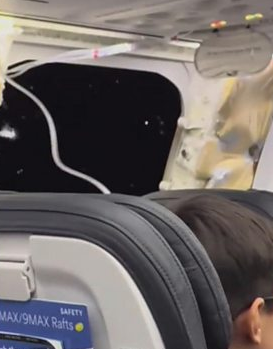The US airline regulator has ordered the grounding of some Boeing 737 Max 9 jets after part of one plane fell off during an Alaska Airlines flight.

The Federal Aviation Administration (FAA) said the inspections would affect 171 planes.
On Friday the Alaska Airlines flight had to make an emergency landing after take-off from the US state of Oregon.
United Airlines says it has carried out the inspections required by the FAA on some of its 79 Boeing 737 Max 9 planes.
Removing some of the aircraft from service was expected to cause about 60 cancellations on Saturday, the airline said in a statement.
Earlier, the FAA said it would “order the temporary grounding of certain Boeing 737 Max 9 aircraft operated by US airlines or in US territory”.
Required inspections would take around four to eight hours per aircraft, it said.
Turkish Airlines has also recalled its five planes of that model for checks.
In Friday’s incident, the Alaska Airlines flight from Portland, Oregon to Ontario, California, had reached 16,000ft (4,876m) when it began its emergency descent, according to flight tracking data.
The airline, carrying 177 passengers and crew, landed safely back in Portland.
The chair of the National Transportation Safety Board (NTSB), which is investigating the incident, confirmed on Saturday that nobody had been sitting next to the affected section.
“We are very, very fortunate here that this didn’t end up in something more tragic,” Jennifer Homendy said.
She added that investigators believed the door that came off the plane was now in the Cedar Hills neighbourhood in Portland and urged anyone who found it to contact local police.
Meanwhile, the UK’s Civil Aviation Authority (CAA) confirmed that there were no UK-registered 737 Max 9 aircraft.
“We have written to non-UK and foreign permit carriers to ask inspections have been undertaken prior to operation in UK airspace,” it wrote on X, formerly Twitter.
Images sent to news outlets of the affected area showed the night sky visible through the gap in the fuselage, with insulation material and other debris also seen.
There were no immediate indications of the cause of the apparent structural failure, nor any reports of injuries.
Passenger Evan Smith said: “There was a really loud bang towards the left rear of the plane and a woosh noise – and all the air masks dropped.
“They said there was a kid in that row who had his shirt sucked off him and out of the plane and his mother was holding onto him to make sure he didn’t go with it.”
In an audio clip, the pilot can be heard talking to air traffic control requesting a diversion.
“We are an emergency,” she said. “We are depressurised, we do need to return back.”
According to photographs, the affected area was in the back third of the plane, behind the wing and engines.
The section of fuselage involved appears to be an area that can be used as an additional emergency exit door by some operators, but not by Alaska.
Terry Tozer, a former airline pilot who has written extensively on aviation safety, said the section should have been bolted into place if it was not being used as an emergency exit.
He told the BBC News Channel that the passengers would not have been able to tell the area was not a normal window from inside the cabin.
While the loss of this section would probably not have affected how the aircraft flew, Mr Tozer added, there would have been a “huge risk” to anyone sitting nearby.
Announcing the initial grounding of 65 planes, Alaska Airlines’ CEO Ben Minicucci said: “Each aircraft will be returned to service only after completion of full maintenance and safety inspections.”
A later statement said that more than a quarter of those planes had been inspected and would return to service as there were no issues found.
In a statement, Boeing said it supported the FAA’s decision. and was co-operating with the National Transportation Safety Board’s investigation of the Alaska Airlines incident.
“Safety is our top priority and we deeply regret the impact this event has had on our customers and their passengers,” Boeing said.
It is the latest problem involving Boeing’s best-selling model, which was grounded for almost two years following crashes in 2018 and 2019.
BBC News




